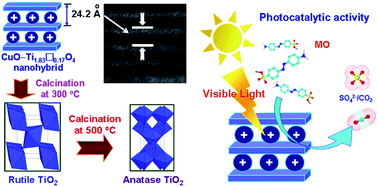Unique phase transformation behavior and visible light photocatalytic activity of titanium oxide hybridized with copper oxide
Abstract
The nanoscale hybridization of

* Corresponding authors
a
Center for Intelligent Nano-Bio Materials (CINBM), Department of Chemistry and Nano Sciences, Ewha Womans University, Seoul, Korea
E-mail:
hwangsju@ewha.ac.kr
Fax: +82-2-3277-3419
Tel: +82-2-3277-4370
b Department of Materials Science and Engineering, Yonsei University, Seoul, Korea
The nanoscale hybridization of

 Please wait while we load your content...
Something went wrong. Try again?
Please wait while we load your content...
Something went wrong. Try again?
T. W. Kim, H. Ha, M. Paek, S. Hyun, J. Choy and S. Hwang, J. Mater. Chem., 2010, 20, 3238 DOI: 10.1039/B922510B
To request permission to reproduce material from this article, please go to the Copyright Clearance Center request page.
If you are an author contributing to an RSC publication, you do not need to request permission provided correct acknowledgement is given.
If you are the author of this article, you do not need to request permission to reproduce figures and diagrams provided correct acknowledgement is given. If you want to reproduce the whole article in a third-party publication (excluding your thesis/dissertation for which permission is not required) please go to the Copyright Clearance Center request page.
Read more about how to correctly acknowledge RSC content.
 Fetching data from CrossRef.
Fetching data from CrossRef.
This may take some time to load.
Loading related content
